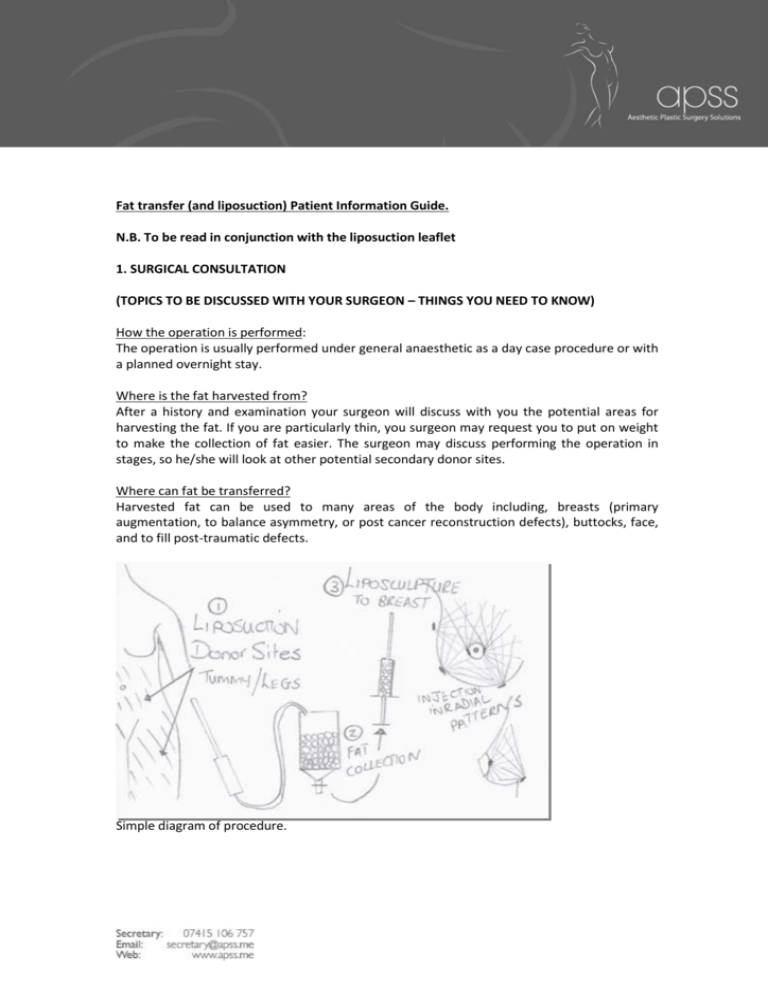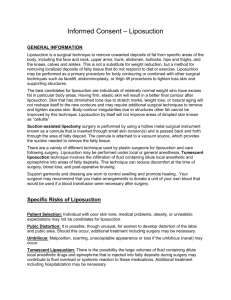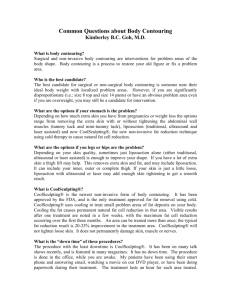Fat transfer (and liposuction) Patient Information Guide. N.B. To be
advertisement

Fat transfer (and liposuction) Patient Information Guide. N.B. To be read in conjunction with the liposuction leaflet 1. SURGICAL CONSULTATION (TOPICS TO BE DISCUSSED WITH YOUR SURGEON – THINGS YOU NEED TO KNOW) How the operation is performed: The operation is usually performed under general anaesthetic as a day case procedure or with a planned overnight stay. Where is the fat harvested from? After a history and examination your surgeon will discuss with you the potential areas for harvesting the fat. If you are particularly thin, you surgeon may request you to put on weight to make the collection of fat easier. The surgeon may discuss performing the operation in stages, so he/she will look at other potential secondary donor sites. Where can fat be transferred? Harvested fat can be used to many areas of the body including, breasts (primary augmentation, to balance asymmetry, or post cancer reconstruction defects), buttocks, face, and to fill post-traumatic defects. Simple diagram of procedure. How does fat transfer work? Fat is harvested by liposuction (see attached liposuction leaflet) Once the fat is collected, it undergoes a process of cleaning (through filters) or centrifugation (spinning at speed). This fat can then be re-injected into the relevant recipient site (e.g. breast). The next crucial stage is up to your own body where the transferred fat picks up a blood supply from the surrounding tissues. This need to occur within the first few days, otherwise the fat will die and be absorbed by your body. How much survives? Different areas have different levels of fat survival, studies report around 60-80%, with the best results clinically with transfer in the breast. There is a natural balance in the tissues with respect to tissue tension/pressure and fat picking up a blood supply. Too much tension i.e. forcing too big a volume into an area, will result in a poor survival of the fat. If you are requesting a significant change, you will need to be prepared to have repeated surgeries to gain the desired affect. The site of the Incision: The ideal scar is a hidden one, and for fat transfer small stab incisions with a needle need to be made. Your surgeon will explain his/her preferred technique, and demonstrate where the incisions are to be placed. These will often be placed in natural folds or hidden at junctions between areolar and normal breast skin for example. Wound closure: The stab incisions are usually closed with a small absorbable suture. This suture does not need to be pulled out, and will fall out naturally by itself after a few days. The wound may be sealed with a specialized Tissue glue and covered by a small waterproof dressing. Surgical drains No drains are needed in liposuction and fat transfer. Asymmetry: We are all born with some minor asymmetry, which is entirely normal. Your surgeon will try to adjust this as best he/she can during the procedure, but if differences still remain after the operation we accept that it is within normal limits. Potential risks of the operation (some similarities to liposuction): 1) Swelling and bruising – this is not uncommon to have swelling/bruising, which may take a few weeks to settle and is to be expected/anticipated. Your final result will only be seen around 4months post op. 2) Bleeding – If it occurs simple pressure is applied over the area. It may be more swollen for a period of time, but will settle. You do not need to return to theatre. 3) Pain -You will not be allowed home until you are comfortable and pain free. We send you home with a range of different painkillers (mild, moderate and strong) and a course of oral antibiotics as part of our standard package of care. 4) Infection –We make every effort to limit the risk of infection, however if after the operation the wounds become red, hot, swollen or there is a discharge from the wound we need to see you straight away and the area treated with appropriate antibiotics and specialized dressings. 5) Scarring – The size length and position of the scar would have been discussed with you in your pre-operative consultation. However, everybody heals differently and all scars usually will be a bit red and raised and lumpy for the first few months and then take around 1 or 2-years to fade. 6) Alteration in sensation- it is not uncommon to have altered sensation around the operation area including the scar. This can cause areas of hypersensitivity, but is temporary and will usually improve over the coming week. 7) Collection of fluid (Seroma) – this is a collection of fluid found in the potential space left by the liposuction of fat. If it is small your body will absorb this over time. If it is uncomfortable the collection can be simply drained in a matter of minutes with a needle and syringe. 8) Fatty lumps/cysts – in areas of liposuction or transfer fat cells can become damaged and form cysts or hared lumps. If this occurs and the areas are symptomatic further surgery may be required. 9) Revision surgery – the beauty of this technique is that you can use your own tissues to your advantage, remove from areas you dislike and inset the fat where you need it. If after the operation there are areas that are asymmetrical due to the liposuction and or variable fat “take”, further surgery can be performed. If this is minor, it can be done under local anaesthetic as a day case procedure. DO NOT HESITATE TO CONTACT US IF YOU HAVE ANY CONCERNS. Post-operative dressings/support: You will wake up in recovery with simple dressings covering the wounds. The liposuction area will have a pressure garment over it, but it is crucial that NO PRESSURE IS PLACED ON THE RECEPIENT SITE for at least the first 2 weeks, better if its 6 weeks. What about pain relief and antibiotics: You will not be allowed home until you are comfortable and pain free. We send you home with a range of different painkillers (mild, moderate and strong) and a course of oral antibiotics as part of our standard package of care. Pre-assessment: You will require an assessment with the nursing team a few weeks before surgery. Ideally this is done face to face, but may on occasion be done telephonically. During this period you will have an opportunity to discuss any aspect of your surgery at that time. 2. PREPARATION BEFORE SURGERY It is advised that you undertake all of the household duties prior to your admission to hospital, as you will not be able to perform these for a while afterwards. This includes vacuuming, dusting, and clothes washing, ironing and shopping i.e. no pushing, pulling, lifting You may take ARNICA tablets (unless contraindicated) prior to your surgery to reduce bruising. These can be purchased from health food stores and leading chemists. It is suggested that you take 2 tablets 3 times a day, 2 or 3 days before surgery, but OMIT on the day of the operation, then recommence the day after surgery for a further 1week. DO NOT take any Aspirin or medication containing Aspirin for at least 7 days prior to surgery. (Aspirin may be re commenced after 48hrs post op.) If you take Aspirin or any other form of blood thinning medication for a medical condition, please discuss with your surgeon. Food and drink If you are having a general anaesthetic, NO food for 6 hours before your admission. After that time you may drink only small sips of clear fluid (i.e.; black tea, black coffee, water only) up to 2 hours prior to your admission. 3. WHAT HAPPENS ON THE DAY OF THE OPERATION On arrival you will have routine observations performed and a check of all the relevant paperwork carried out by the nursing staff. Then you will be asked to change into a gown. All your jewellery must be removed, including ALL metal body piercings. It is recommended that you do not bring anything of value into hospital. All makeup must be removed as it can damage your eyes if left on while you are asleep. You must also remove all nail varnish and acrylic nails. What will happen when I wake up? As you wake up, in the recovery ward you will find you have been positioned in a particular way that relates to the area of fat transfer. Where possible we would like this area elevated and not under any pressure, for example on the breast we would be sitting you upright. You will be allowed out of bed to pass urine (water) with the assistance of the nursing staff the first time, in case you feel lightheaded. If you are requested to be sitting more upright than normal for the first few day after the operation, it is quite common for the small of your back to be uncomfortable. It helps if you move slightly from one buttock to the other to relieve the pressure. 4. AFTER YOUR OPERATION Travelling – home and afterwards It is recommended that you do not drive for 14 days following surgery. Please check your own car insurance company rules, as they are all different. Follow up wound care You will need to return to your hospital/ medical centre after one week. This appointment will be made at the time of your pre-assessment. At Home It is important that you have total rest. This means do nothing that will raise your blood pressure, including physical activities, sexual activities and housework during the first 2 weeks. This could induce a bleed, and add to the swelling. You can potter about and undertake activities that do not involve pulling, pushing and lifting. 5. AFTER THE FIRST TWO WEEKS Start returning to your normal activities of living. Be sensitive to your body and try not to do too much too soon. Therefore, if you experience any pain, stop and try again another day. You can drive and start lifting light objects from 2 weeks. You may start lower leg exercise after 4 weeks. Strenuous Gym activities, aerobics or sports should be avoided for six weeks. Skin care do not be scared to gently rub massage the liposuction areas after the first 2 weeks as this will help with swelling in the tissues. From 6 weeks on gentle massage along the scar in circular motions will help with scar softening. 6. GENERAL INFO /FAQ’S Sleeping: Depending on the area treated with liposuction you may be asked to lie in a different positions to help with swelling and pain relief. Pain: It will be uncomfortable over the first few days; this varies from person to person. Analgesia (painkillers) will be prescribed to take home. Work / Sport / Leisure: It is recommended that you take 2weeks off work. If you have an active hobby / leisure interest, please ask the surgeon or nurse for advice. It is also advisable to avoid bending forward too much at first. Bathing: Please keep the wounds dry for the first week. After you first post-operative check with the nurse at 1 week, you will be advised if you can then shower. Sun Bathing: Do not sit out in strong sun for the first 2 weeks after surgery. Diet: Maintain a healthy nutritious diet with plenty of fruit and vegetables, as this is important for wound healing and bowels. Bowels: As you are inactive and due to use of painkillers, you may become constipated. For your own comfort and wellbeing, prevent this from happening. Purchase an aperient such as Senokot® or what ever has suited you in the past. Flying: If possible avoid flying for the first six weeks, wear flight socks and take low dose aspirin before flying.






